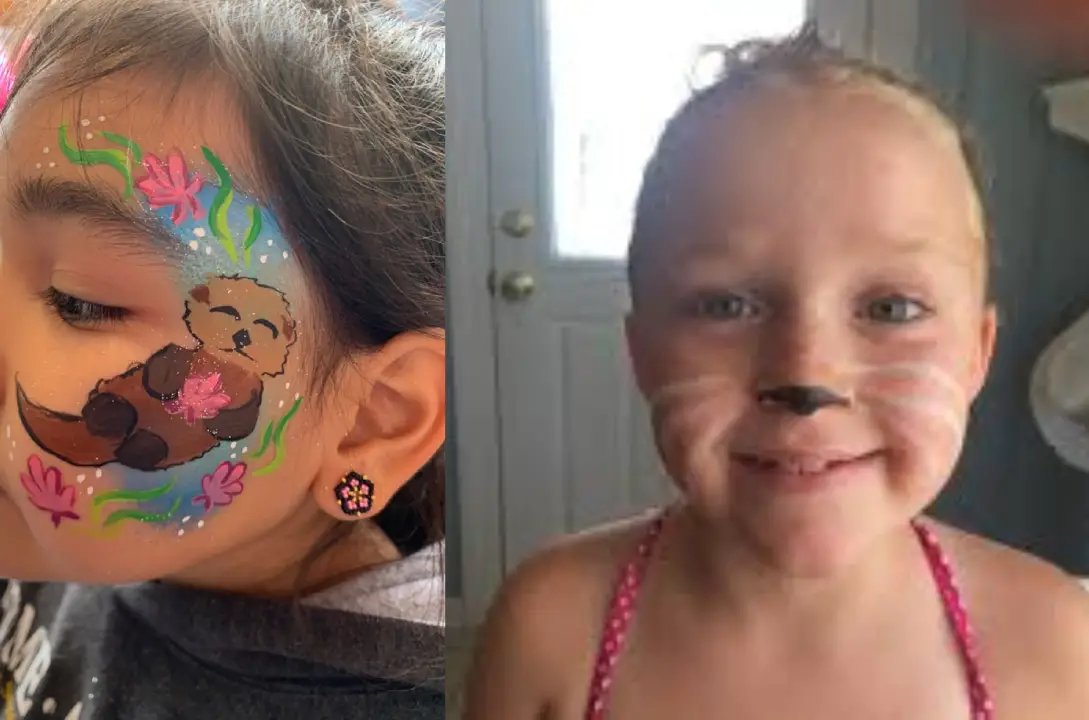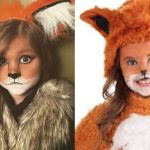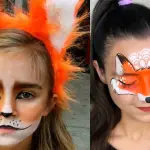When it comes to kid-friendly makeup, few looks are as charming and fun as sea otter makeup. The adorable and expressive faces of sea otters make them a delightful choice for Halloween, costume parties, or even just a playful afternoon of face painting.
If you’ve ever wondered how to do sea otter makeup on your kids in a way that’s simple yet captivating, you’ve come to the right place. You need some simple tools to get this done:
- Non-toxic face paint in brown, black, and white
- Makeup brushes or sponges
- Water to activate the face paint
Once you have gathered this simple tools, you just need to follow this simple steps:
- Prepare the Face: Apply a thin layer of white face paint to the child’s face as a base.
- Create the Otter Shape:
- Use brown face paint to outline the otter’s body shape, including the head, belly, and tail.
- Make the head slightly rounded and the tail long and tapered.
- Add Details:
- Use black face paint to create the otter’s nose, whiskers, and eyes.
- Add small white circles around the eyes to represent the otter’s fur.
- Draw a small, upside-down triangle for the nose and two dots for nostrils.
- Use a thin brush to draw whiskers on either side of the nose.
- Finish the Look:
- Use a sponge to lightly blend the edges of the brown and black paint for a softer look.
- Add a few white spots to the otter’s body to mimic its fur.
Now let’s dive in to learn all you need to know about creating that lovable sea otter look, from materials and setup to the finishing touches on the whiskers and fur! This guide is structured to help you go through each step smoothly so you and your little one can focus on the fun of transforming into a sea otter together.
Materials You Need
When it comes to how to do sea otter makeup on your kids, gathering quality materials is the first crucial step. Quality face paint and tools will not only make the application easier but also ensure that your child’s skin remains safe and comfortable throughout the process. Here’s a list of essentials to have on hand:
- Face Paints: Use water-based, non-toxic face paints specifically designed for sensitive skin, especially for children. A few colors you’ll need include brown (for fur), white (for highlights), black (for nose, eyes, and whiskers), and a bit of pink if you’d like to add a rosy touch to the cheeks.
- Brushes and Sponges: A set of soft makeup brushes and sponges will make application smoother and give you more control over the details. Fine brushes are perfect for drawing whiskers, while wider brushes or sponges work well for filling in larger areas like the fur.
- Setting Spray or Powder: If your child is going to be in their sea otter makeup for a longer period, setting spray or powder can help the makeup stay in place without smudging.
- Wet Wipes and Cotton Swabs: These will be essential for cleaning up any smudges or mistakes as you go along.
- Mirror: A mirror can be helpful for you to check your work or for your child to see the transformation.
Clean and Prepare Your Child’s Face
Before diving into the makeup application, it’s important to prep your child’s skin. Prepping ensures that the makeup applies smoothly and stays comfortable, especially if they’ll be wearing it for an extended period. Here’s how to get their face ready:
- Clean the Skin: Start with a clean canvas by gently washing your child’s face with a mild cleanser. This will remove any dirt or oils that might prevent the makeup from adhering well. After washing, gently pat the face dry with a soft towel.
- Moisturize: Apply a light, fragrance-free moisturizer. Moisturizing keeps the skin hydrated, which helps the face paint go on more evenly and prevents cracking or dryness. Let the moisturizer sit for a minute or two to absorb fully.
- Apply a Primer (Optional): If you have face primer on hand, a small dab can help keep the makeup in place. This step isn’t essential, but it can be particularly useful if you’re applying sea otter makeup for a long day of activities, like a Halloween parade or costume party.
- Choose a Comfortable Seating Position: Position your child in a comfortable chair with good lighting. Make sure they’re seated at a height where you can easily access their face without having to strain or stoop.
- Prepare for Movement: Kids can get wiggly, so it helps to keep their hands busy. Give them a small toy or ask them to look into a handheld mirror to watch their transformation.
Create the Otter’s Nose and Whiskers
Now it’s time to bring out the features that will make your child look like a real sea otter! The nose and whiskers are the main focus here, and they’ll add a lot of character to the overall look. Let’s break it down step-by-step:
- Draw the Nose: Using a fine-tipped brush and black face paint, start by creating a small, rounded triangle shape right on the tip of your child’s nose. The triangle should be wide at the top and taper down slightly at the bottom to resemble an otter’s nose. Make sure the edges are smooth and even—if you need to, use a cotton swab dipped in water to clean up any mistakes.
- Fill in the Nose: Once the outline is complete, fill in the nose shape with the same black paint. You can use a medium-sized brush or a sponge applicator to fill in the triangle fully. If you’d like to add some shine, dab a tiny bit of white paint near the top edge of the nose to create a “highlight” effect, making it look more realistic.
- Add the Whiskers: Otters are known for their expressive, long whiskers, so this part really brings the look together. Using the same fine brush and black paint, start from either side of the nose and draw three to four whisker lines extending out toward each cheek. Try to make each whisker slightly curved rather than perfectly straight to capture that playful otter look. Keep the lines thin and light for a natural appearance, and if you need to, go over each line twice to make sure it stands out.
- Optional – Add Freckles: For an extra touch of cuteness, you can add small dots or “freckles” around the nose and cheeks. Dip the tip of a fine brush or even a toothpick in black paint, and add a few tiny dots just above where the whiskers begin. This will give the face more dimension and make it look even more otter-like.
Add the Otter’s Eyes
Creating the eyes is essential for capturing that endearing, gentle look sea otters are known for. This part is all about making the eyes appear larger, rounder, and full of expression. Here’s how to do it step-by-step:
- Outline the Eye Area: Using black or dark brown face paint, draw a semi-circle around each eye. Start from the lower lash line and bring the line around the outer edge of each eye, curving slightly upwards. This outline should be subtle yet wide enough to enhance the natural shape of the eye.
- Add White Highlights: Sea otters have a playful sparkle in their eyes, and you can capture this by adding a small white dot at the inner corners of each eye. Using a fine brush, apply a tiny dab of white paint just at the inner edge to give a soft glint. This helps the eyes appear larger and more expressive.
- Shade the Under-Eye Area: To add depth, use a light brown shade to gently shade underneath each eye. This shading should be light and blend seamlessly into the skin. You can use a small brush or even a makeup sponge for this. The shading under the eyes gives a slight contour effect, making the eyes stand out even more.
- Optional – Add Eyebrows or Lashes: For added expression, you can lightly paint thin black lines above the eyes as “eyebrows” or add small lash-like strokes at the outer edges. This isn’t necessary but can give an extra level of detail that makes the otter face even cuter.
Paint the Otter’s Fur
Now that you have the nose, whiskers, and eyes set, it’s time to add the finishing touch: painting the fur! This step is where your little one truly transforms into an adorable sea otter. Let’s go through the process of creating a lovely fur pattern that will bring the entire look together.
- Base Layer of Brown: Start with a medium-sized brush and your brown face paint. Cover the cheeks, forehead, and chin with a solid layer of brown, making sure to blend the edges so that it flows well with the features you’ve already painted. This will serve as the base for the otter’s fur.
- Create Fur Texture: Once the base is dry, use a smaller brush to add texture to the fur. Dip the brush lightly in the same brown paint or a slightly darker shade for added depth. Using short, quick strokes, begin painting small lines and flicks of color starting from the edges of the brown areas, moving inward. This technique mimics the soft, fluffy appearance of fur. Focus particularly on the edges around the cheeks and forehead, where otters typically have a denser coat.
- Add Highlights with White: To enhance the three-dimensional look of the fur, apply highlights using white or a very light brown. Lightly brush over areas where light would naturally hit—like the tops of the cheeks, the bridge of the nose, and the forehead. Use a clean brush and a light hand, as you want to create subtle highlights rather than overpowering the base color.
- Paint the Ears: Don’t forget the ears! If your child’s hair will cover their ears, you can skip this step, but if not, use your brown face paint to create a rounded shape on the top of their head to represent the otter’s ears. Add a touch of white in the center of the ear for a cute contrast.
- Final Touches: After applying all the colors, step back and assess the overall look. Make any necessary touch-ups, adding more fur texture or adjusting the highlights.
Conclusion
With this steps, you’ve successfully learned how to do sea otter makeup on your kids! With a little patience and creativity, you’ve transformed your child into an adorable sea otter that is sure to bring smiles and joy. This delightful look is perfect for Halloween, themed parties, or simply for playtime fun.
To recap, the key steps included gathering your materials, prepping your child’s face, creating the otter’s nose and whiskers, adding those expressive eyes, and painting the fur to capture the essence of these lovable creatures. Remember, the joy of face painting lies not just in the final product but in the experience of creating something special together. Encourage your child to participate in the process—whether it’s choosing colors or helping with the application, the experience can be a bonding time filled with laughter and creativity.
As you dive into the world of face painting, don’t hesitate to explore variations on the sea otter look. Consider different color palettes, adding accessories like a cute hat, or even incorporating other ocean themes to create an entire family of sea creatures!



